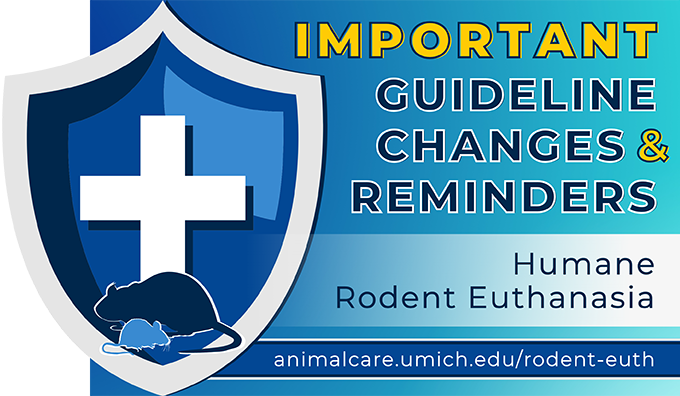You are here
- Home
- Announcements
- Updated Guidelines for Humane Rodent Euthanasia
Updated Guidelines for Humane Rodent Euthanasia
 The Institutional Animal Care & Use Committee (IACUC) has recently approved several important changes to the guidelines for humane rodent euthanasia.
The Institutional Animal Care & Use Committee (IACUC) has recently approved several important changes to the guidelines for humane rodent euthanasia.
These changes are summarized below and available in the revised Guidelines for Rodent Euthanasia Procedures for Investigative Personnel document available on the Animal Care A-Z website.
All personnel who perform rodent euthanasia, especially in mice and rats, should review the revised guidelines and important reminders below to ensure that they understand their individual responsibility for safeguarding animal welfare and minimizing any potential sources of distress throughout the entire procedure – including consolidation, handling, and transport.
The revised guidelines will take effect on January 1, 2023.
Changes have been announced now to provide labs sufficient time to make any necessary modifications to their existing processes, consult with their ULAM Faculty Veterinarian on questions or concerns, and seek additional training or education as needed.
After January 1, individuals who are found to be conducting procedures inconsistent with institutional guidelines and/or their IACUC approved protocol may be reported for non-compliance, pursuant to standard practices.
IACUC inspectors may also inquire about these changes during the Winter 2023 round of semi-annual inspections, tentatively scheduled for February and March.
- Information has been added to provide additional clarity on –
- What rodent species (only mice and rats) can be consolidated prior to euthanasia
- How to identify compatible animals if consolidation is necessary for mice. Note that animals with a previous history of demonstrated aggression should never be consolidated.
- Where (e.g., in the animal housing room or at the euthanasia station) consolidation is permitted. To reduce stress and avoid potential injuries, weaned male mice should not be consolidated in the animal housing room.
- When CO2 is effective as a primary euthanasia method and when other primary methods should be utilized.
- The title of the document has been changed from “Mouse and Rat Euthanasia Procedures” to “Rodent Euthanasia Procedures” to reflect the inclusion of other rodent species (e.g., voles, grass rats, jerboas, spiny mice)
- Euthanize animal(s) in their home cage whenever possible to minimize stress
- Do not consolidate incompatible animals or any rodents except for mice and rats
- Follow standard housing densities when consolidating rodents (except mice) for euthanasia. For mice –
- Maximum of 10 mice in a standard (#1) mouse shoe box cage
- Maximum of 25 mice in a large mouse/small rat (#3) cage
- Provide ample space for animals to move and assume normal postures
- Start the procedure no more than 10 minutes after the animals have been consolidated
- Set aside plenty of time for consolidation (if necessary), animal transport**, the procedure, and proper carcass disposal.
- Never leave animals alone during the procedure
- Perform a secondary method of euthanasia
- Always follow the procedures outlined in your IACUC approved protocol
**Please note that you may need to procure additional carts to transport additional cages. Do not use ULAM carts unless prior approval has been received from your facility’s ULAM Husbandry Supervisor.
Additional Information & Resources
![]() Download the Quick Reference Sheet: Guidelines for Rodent Euthanasia Procedures (available via PDF download
Download the Quick Reference Sheet: Guidelines for Rodent Euthanasia Procedures (available via PDF download ![]() ) for a high-level overview of CO2 euthanasia processes and many of the important reminders referenced above.
) for a high-level overview of CO2 euthanasia processes and many of the important reminders referenced above.
Quick reference posters, animal housing room reminders, and step-by-step instructional flip charts for CO2 euthanasia stations will be posted throughout all animal care facilities in the coming weeks to help acclimate individuals to these revised guidelines and procedures.
Questions?
- Please reach out to your ULAM Faculty Veterinarian with any additional questions or concerns you may have about performing CO2 euthanasia in rodents.
- If you don’t know your veterinarian, send an email to ulam-questions@umich.edu and your question will be routed appropriately.
Thank you for your thoughtful attention to this matter. It is critical that all animals continue to receive compassionate and humane care throughout the entirety of their lives.
![]() Links marked with a lock icon can only be accessed using valid Level-1 U-M login credentials.
Links marked with a lock icon can only be accessed using valid Level-1 U-M login credentials.